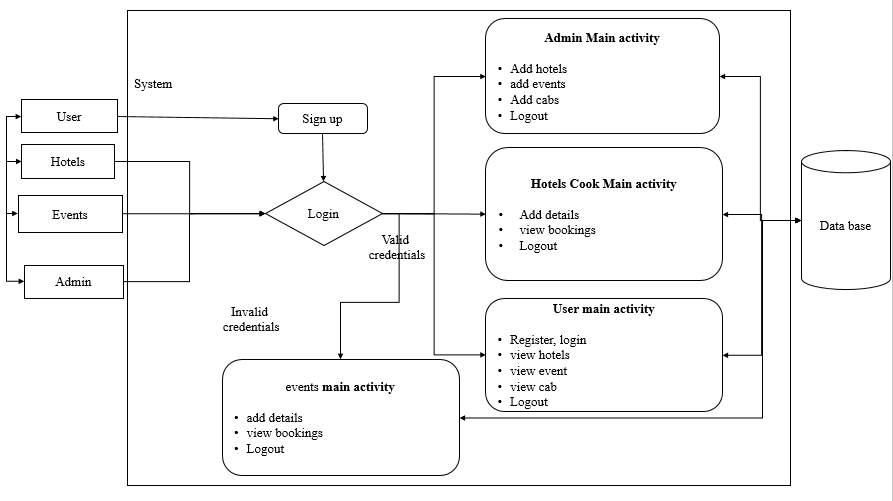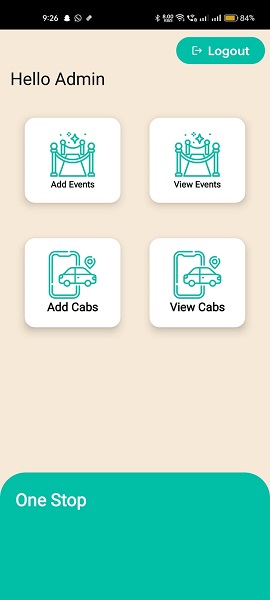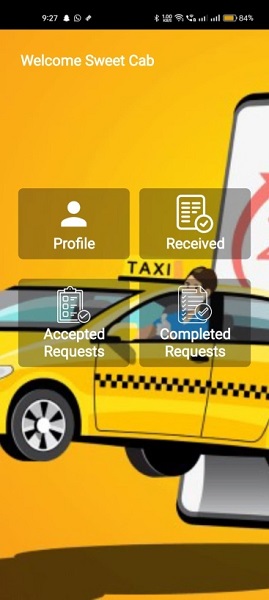Ijraset Journal For Research in Applied Science and Engineering Technology
- Home / Ijraset
- On This Page
- Abstract
- Introduction
- Conclusion
- References
- Copyright
A One Stop Solution for Tourism
Authors: V. Ramabai, D. Riyaz, M. Kiran Kumar, D. Sai Jaswanth, S. Sapthagiri
DOI Link: https://doi.org/10.22214/ijraset.2025.66479
Certificate: View Certificate
Abstract
This project focuses on developing an intuitive system that enables efficient management and discovery of hotels, events, and cabs. The Admin has the ability to add various places such as hotels, events, and cabs for users to explore. Additionally, hotels and event organizers can input details and view bookings, streamlining their operations. Users can register and log in to view and explore hotels, events, and cabs that have been added by the Admin. The system enhances the user experience by offering a centralized platform for place discovery and bookings. The platform ensures seamless interactions between users and place providers, making it easier for users to find and book hotels and events, while admins manage and update offerings effectively.
Introduction
I. INTRODUCTION
The motivation behind this project stems from the growing demand for streamlined services in the hospitality and event sectors. By addressing the complexities of booking and management, we aim to enhance user convenience, optimize service provider operations, and foster a seamless experience, ultimately contributing to the digital transformation of service industries. Current systems for managing hotels, events, and cabs often lack user-friendly interfaces and centralized features, leading to inefficiencies in booking and service discovery. This project addresses these issues by creating an integrated platform that simplifies interactions for users and providers, ensuring streamlined operations and improved overall user experiences. The objective of this project is to develop an intuitive platform that facilitates the efficient management and discovery of hotels, events, and cabs. The system aims to streamline operations for admins and event organizers while providing users with a seamless experience for exploring and booking various services. Ultimately, it enhances interactions between users and service providers for convenient access and management. The scope of this project includes developing a centralized platform for managing hotels, events, and cabs, featuring user registration, admin management, and booking functionalities. It encompasses the integration of intuitive interfaces for users and service providers, enhancing operational efficiency and user engagement while allowing for future scalability and feature expansion. In today’s fast-paced world, the need for efficient management and discovery of services like hotels, events, and cabs is paramount. Traditional systems often fall short in providing a seamless user experience, leading to frustration and inefficiencies. This project aims to develop an intuitive platform that centralizes the exploration and booking of various services, catering to both users and service providers. With features for user registration and admin management, the system empowers admins to add and update offerings while allowing users to easily discover and book hotels and events. By streamlining interactions between users and providers, this project enhances overall satisfaction and operational efficiency, ultimately revolutionizing the way individuals engage with hospitality and event services in a competitive digital landscape.
II. LITERATURE SURVEY
The tourism industry has seen a major shift with the rise of technology. A comprehensive solution for tourism seeks to bring together various services such as travel booking, accommodation, local transportation, itinerary planning, and tourist information into one platform. This literature survey examines current research and solutions that aid in the creation of all-encompassing tourism platforms.
A. Existing Tourism Platforms
Online Travel Agencies (OTAs): Websites like Expedia, Booking.com, and TripAdvisor offer booking services for flights, hotels, and car rentals. However, these platforms often fall short in providing personalized itinerary planning and integrated local services.
Super Apps: Applications like WeChat and Grab have incorporated tourism-related services by merging ride-hailing, hotel bookings, and local guides. Nonetheless, their focus tends to be region-specific, which limits their global reach. Destination Management Systems (DMS): DMS platforms are designed to oversee tourism services at a regional level, offering information and booking options. Examples include VisitScotland and Australia.com, which concentrate on promoting destination-specific services.
B. Key Technologies in Tourism Platforms
Artificial Intelligence (AI): AI-powered recommendation systems tailor travel experiences by examining user preferences and behaviors. Chatbots improve customer support by delivering real-time assistance.
Blockchain: Blockchain technology guarantees secure transactions and transparent reviews, tackling trust issues in service bookings.
Internet of Things (IoT): IoT devices facilitate smart tourism by supplying real-time data on transportation, weather, and crowd management.
Augmented Reality (AR) and Virtual Reality (VR): AR/VR technologies provide immersive experiences, allowing tourists to explore destinations virtually before their actual visit.
C. Challenges in Developing One-Stop Solutions
Integration of Services: Merging various services (transportation, accommodation, local guides) into a cohesive platform is complex.
III. REQUIREMENTS
A. Function and Non-Functional Requirements
There are a number of processes that are vital in establishing the efficacy of assimilation of a system or a software project in what is referred to as a requirement’s analysis. Requirements are generally divided into two groups: Functional and non-functional requirements.
B. Functional Requirements
The end user will always have certain baseline requirements that they must be met by the software, and these are referred to as functional requirements. All of these functions must be included in the software as a contractual obligation. These are expressed or defined out in terms of the data that is to be entered in the system, the action taken in the system and the results achieved.
C. Functional Requirements Examples
- Whenever user logs into the system, he/she has to go through an authentication process.
- Call system in case of cyber attack.
These are the largely constraints that the system is required to meet as per the provisions of the contract of the project. The level of implementation of these varies from project to project. Also non-functional.
These requirements mostly address questions relating to:
• Portability
• Security
• Maintainability
• Reliability
• Scalability
• Performance
• Reusability
• Flexibility
D. Non – functional Requirements some Examples Include
- These activities should have the duration of no longer than 12 hours when sending an email.
- Each and every request should be processed and completed within 10 seconds.
- If there are more than 10000 simultaneous users, the site should respond and load in 3 seconds.
E. Hardware Requirements
• Processor - I3/Intel Processor.
• RAM - 8 GB.
• Hard - 1TB.
F. Software Requirements
• Operatiing - Windows10
• JDK- Java.
• Plugin -Kotlin.
• SDK- Android.
• IDE- Android studio.
• Database- MySQL with php.

G. User Interface Design
1) Admin Interface
The administrator interface consists of a dashboard from which a variety of tasks can be performed including managing users, data of inspection bookings, assigning tasks to workers and even supervise the progress of the respective inspection.
2) User Interface
The interface is easy to use and is self-explanatory making it easy for users to create accounts along with booking inspections and being able to view their request status.
3) Worker Interface
The worker’s interface allows the workers to login, see the tasks assigned by admins and change the status of inspections once they are completed.
H. Inspection Process Workflow
1) Booking Process
Tea inspection can be booked by users through the mobile application and they can freely provide the information necessary that includes preferred date, location and type of the inspection required.
2) Task Assignment
All the needs for inspections along with the information provided during the booking are then reviewed. After, the admins assign workers with the tasks according to their availability.
I. Existing System
Existing systems for managing hotels, events, and cabs are often fragmented, requiring users to navigate multiple platforms for bookings. These systems typically lack centralization, leading to inefficiencies in service discovery and management. Admins and service providers face challenges in updating offerings, while users experience a lack of streamlined access to services, resulting in a less efficient experience. 4o
J. Disadvantages
• Fragmented platforms create inefficiencies in booking and service discovery.
• Admins struggle with updating offerings across multiple, disconnected systems.
• Users face challenges accessing centralized services for seamless booking experiences
IV. EXPECTED OUTCOMES
Table I. Comparison of Online Inspection Systemvs. Traditional Approach
|
Outcome |
Online Inspection System |
Traditional Approach |
|
Operational Efficiency |
Automates inspection, reducing time spent on manual tasks. Streamlined and faster process. |
Relies on manual processes, leading to slower inspection times and more human involvement. |
|
Data Accuracy |
Real-time updates and digital record-keeping reduce errors and improve accuracy. |
Prone to human error due to manual data entry and paper-based reporting. |
|
Transparency and Accountability |
Users can track inspections in real-time, ensuring full visibility and transparency. |
Limited visibility for users; information may not be readily available to all stakeholders. |
|
Timely Communication |
Instant updates and real-time communication between Admins, Users, and Workers. |
Communication often delayed, with information passed verbally or on paper. |
|
Traceability |
Detailed history and tracking of all inspections and activities. Easy to audit. |
Poor traceability due to reliance on paper-based logs and manual record-keeping. |
|
Human Errors |
Reduced reliance on human input, lowering the chance of mistakes in data handling. |
High potential for human error, especially in data entry and reporting. |
|
Resource Management |
Optimizes resources with task automation and efficient scheduling of inspections. |
Resources managed manually, leading to inefficient task allocation and delays. |
|
User Experience |
User-friendly interface that allows easy access to inspection statuses and history. |
Limited user interaction, with reliance on manual updates and verbal communication. |
Overall, the system aims to provide a comprehensive solution that not only enhances the tea leaf plant inspection process but also establishes a foundation for future innovations in agricultural and industrial inspections.
[2] The Online Inspection System offers clear advantages over the traditional approach, significantly improving efficiency, accuracy, communication, and scalability, while minimizing human error and administrative overhead.
V. PSEUDOCODE
package com.project.onestop.ui
import android.content.Intent
import android.os.Bundle
import android.widget.ArrayAdapter
import androidx.appcompat.app.AppCompatActivity
import androidx.core.view.isVisible
import com.project.onestop.R
import com.project.onestop.databinding.ActivityLoginBinding
import com.project.onestop.response.CommonResponse
import com.project.onestop.response.RetrofitInstance
import com.project.onestop.utils.SessionManager
import com.project.onestop.utils.showToast
import kotlinx.coroutines.CoroutineScope
import kotlinx.coroutines.Dispatchers.IO
import kotlinx.coroutines.launch
import retrofit2.Call
import retrofit2.Callback
import retrofit2.Response
class LoginActivity : AppCompatActivity() {
private val bind by lazy { ActivityLoginBinding.inflate(layoutInflater) }
private val shared by lazy { SessionManager(applicationContext) }
override fun onCreate(savedInstanceState: Bundle?) {
super.onCreate(savedInstanceState)
setContentView(bind.root)
if (shared.isLoggedIn()) {
shared.getUserRole()?.let { navigateToDashboard(it) }
}
bind.textviewnew.setOnClickListener {
startActivity(Intent(applicationContext, RegisterActivity::class.java))
}
val roles = resources.getStringArray(R.array.roles)
val adapter = ArrayAdapter(this, android.R.layout.simple_spinner_item, roles)
bind.buttonLogin.setOnClickListener {
val email = bind.editTextEmail.text.toString().trim()
val password = bind.editTextPassword.text.toString().trim()
if (email.isEmpty()) {
showToast("Please enter your email")
} else if (password.isEmpty()) {
showToast("Please enter your password")
} else {
if (email == "admin" && password == "admin") {
shared.saveLoginState("-1", "Admin", "", "", "", "", "", "")
navigateToDashboard("")
finish()
} else {
bind.progressBar.isVisible = true
CoroutineScope(IO).launch {
RetrofitInstance.instance.userLogin(email, password)
.enqueue(object : Callback<CommonResponse?> {
override fun onResponse(
call: Call<CommonResponse?>,
response: Response<CommonResponse?>
) {
val loginResponse = response.body()!!
if (!loginResponse.error) {
loginResponse.data.firstOrNull()?.let { user ->
shared.saveLoginState(
"${user.id}",
user.role,
user.name,
user.location,
user.mobile,
user.email,
user.password,
user.rating
)
navigateToDashboard(user.role)
}
} else {
showToast("Invalid credentials")
}
bind.progressBar.isVisible = false
}
override fun onFailure(call: Call<CommonResponse?>, t: Throwable) {
showToast(t.message ?: "Login failed")
bind.progressBar.isVisible = false
}
})
}
}
}
}
}
private fun navigateToDashboard(role: String) {
val intent = when (role) {
"Cab" -> Intent(this, CabDashboard::class.java)
"Event" -> Intent(this, EventsDashboard::class.java)
"User" -> Intent(this, UserDashboard::class.java)
else -> Intent(this, AdminDashboard::class.java)
}
startActivity(intent)
finish()
}
}
VI. OUTPUTS
1) Home Page

2) Admin Page

3) Cab Page

4) Listed Services

5) Event And Cab Details

VI. DIFFERENCE FROM PROPOSED SYSTEM:
The proposed system provides a centralized platform for managing hotels, events, and cabs, allowing for easy service discovery and booking. Administrators can effortlessly add, update, and manage offerings, while users benefit from a cohesive interface for exploring and reserving services. This platform boosts operational efficiency, enhances user experience, and simplifies interactions between service providers and users, creating a more streamlined service ecosystem.
A. Advantages
- Centralized platform for effective management of hotels, events, and cabs.
- Administrators can easily add, update, and manage service offerings.
- Users experience a simplified process for exploring and booking various services.
- Improves operational efficiency and encourages seamless coordination between users and providers.
Automates Workflows: By automating repetitive tasks such as data entry, inspection tracking, and report generation, the system minimizes manual errors and saves time.
Facilitates Real-Time Data Sharing: It allows for real-time updates from field inspections, ensuring timely communication among stakeholders.
Promotes Scalability: The solution is designed to be adaptable for other agricultural or industrial inspection processes, making it a versatile tool for the long term. Enhances Transparency and Accountability: Features like booking histories, inspection tracking, and role-specific dashboards promote greater accountability and build user trust. Reduces Compliance Risks: By digitizing and standardizing processes, the system ensures improved compliance with operational standards and regulatory requirements
Conclusion
This project successfully creates an intuitive platform for the seamless management and discovery of hotels, events, and cabs. By offering a centralized system, it enhances user experience, facilitating easy exploration and booking of services while also streamlining administrative management. The platform effectively connects users, hotel owners, event organizers, and cab providers, ensuring smooth interactions and efficiency. The platform enhances operations for all parties involved, making both booking and management processes easier, which is advantageous for users and service providers. Its adaptable design allows it to cater to various agricultural sectors and inspection processes beyond just tea leaf plants. This versatility not only ensures the system remains relevant over time but also broadens its use across different industries. With role-based functionality, real-time updates, and thorough tracking, it guarantees a seamless workflow, establishing it as a vital tool for contemporary inspection management. Nonetheless, there is room for future enhancements. Integrating advanced technologies such as Artificial Intelligence (AI) for predictive analysis, the Internet of Things (IoT) for automated data collection, and blockchain for secure data management could greatly improve its functionality. These advancements could result in a more powerful, efficient, and secure system. Future updates might also feature personalized recommendations based on user preferences and booking history, enhanced filtering options for hotels, events, and transportation, as well as multi-language support to boost accessibility. Furthermore, incorporating popular payment gateways could streamline transactions and enhance security. Allowing users to provide reviews and ratings would further improve service quality and reliability, enriching overall user engagement.
References
[1] Wei Wei; Zhengwei Lou; Design and Implementation of Hotel Room Management System; 06-09 December 2019. [2] Karolina Czekalska; Bartosz Sakowicz; Jan Murlewski; Andrzej Napieralski; Hotel reservation system based on the JavaServer Faces technology; 19-23 February 2008. [3] Z. W. Miao; T. Wei; Y. Q. Lan; Hotel\'s online booking segmentation for heterogeneous customers; 04-07 December 2016. [4] Anastasia Bezzubtseva; Dmitry I. Ignatov; The Early Booking Effect and Other Determinants of Hotel Room Prices in Europe; 07-10 December 2013. [5] J. Hu, Chinese Tourism Annual Report 2015. Beijing, NJ: China Travel & Tourism Press, September 2015. [6] X. Guo, L. Ling, C. Yang, Z. Li and L. Liang, “Optimal pricing strategy based on market segmentation for service products using online reservation systems: An application to hotel rooms”, Int. J. of Hospitality Mgnt., vol. 35, no. 12, pp. 274-281, December 2013. [7] T. Koidea and H. Ishiib, “The hotel yield management with two types of room prices, overbooking and cancellations”, Int. J. Production Economics, vol. 93-94, pp. 417-428, January 2005. [8] S. P. Ladany, “Optimal market segmentation of hotel rooms - the non-linear case”. Omega, vol. 24, no. 1, pp. 29–36, January 1996. [9] P. Legoherel, “Toward a market segmentation of the tourism trade: expenditure levels and consumer behavior instability”. J. of Travel & Tourism Mkt, vol. 7, no. 3, pp. 19–39, March 1998. [10] L. Ling, Y. Dong, X. Guo and L. Liang, “Availability management of hotel rooms under cooperation with
Copyright
Copyright © 2025 V. Ramabai, D. Riyaz, M. Kiran Kumar, D. Sai Jaswanth, S. Sapthagiri. This is an open access article distributed under the Creative Commons Attribution License, which permits unrestricted use, distribution, and reproduction in any medium, provided the original work is properly cited.

Download Paper
Paper Id : IJRASET66479
Publish Date : 2025-01-11
ISSN : 2321-9653
Publisher Name : IJRASET
DOI Link : Click Here
 Submit Paper Online
Submit Paper Online

